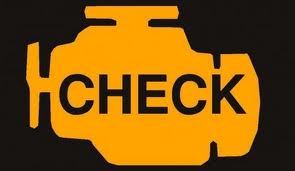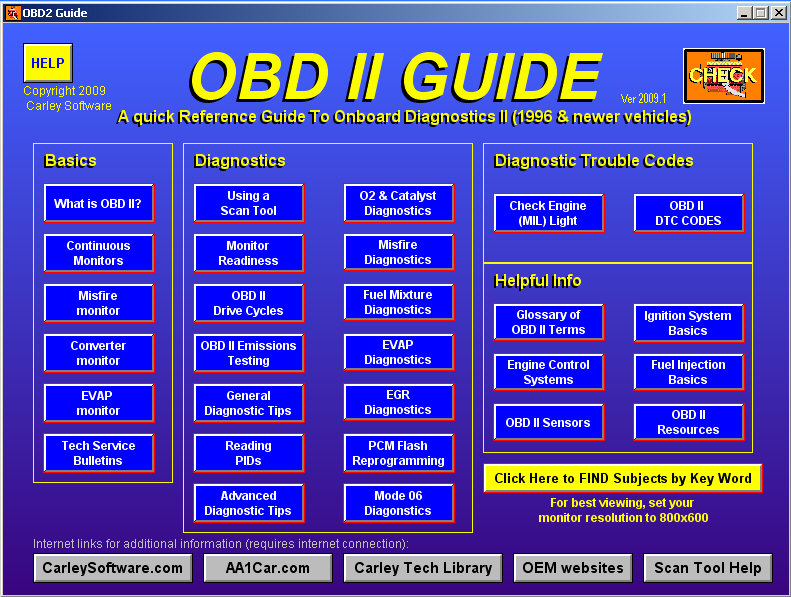What is OBD, and what are its benefits?
OBD stands for “on-board diagnostics,” a computer-based system built into all model year (MY) 1996 and newer light-duty cars and trucks. OBD monitors the performance of some of the engines’ major components, including individual emission controls. The system provides owners with an early warning of malfunctions by way of a dashboard “Check Engine” light (also known as a Malfunction Indicator Light or MIL, for short). By giving vehicle owners this early warning, OBD protects not only the environment but also consumers, identifying minor problems before they become major repair bills.
How do I know the OBD system is working correctly?
When you turn on the ignition, the “Service Engine Soon” or “Check Engine” light should flash briefly, indicating that the OBD system is ready to scan your vehicle for any malfunctions. After this brief flash, the light should stay off while you drive as long as no problems are detected. If so, you’ll be glad to know that your vehicle is equipped with an early warning system that could save you time, money, and fuel in addition to helping protect the environment!
What does it mean if the light turns on while I’m driving?
If the light comes on and stays on, the OBD system has detected a problem. Your vehicle might have a condition that wastes fuel, shortens engine life, or causes excessive air pollution. If left unaddressed, these conditions could also damage your vehicle and lead to increasingly expensive repairs. For example, OBD can identify a loose or missing gas cap (which wastes fuel and contributes to smog) or engine misfire (which can lead to severe or permanent engine damage).
What should I do if the light stays on?
There is no cause for panic. The vehicle is just telling you to seek attention soon. When you reach your destination, make sure the gas cap is not loose or missing. Always turn off your engine when refueling. If the light does not go out after a few short trips following gas cap replacement or tightening, have your vehicle serviced by a qualified repair technician soon! Delaying assistance could lead to more expensive damage.
What does it mean if the light is blinking?
If the light is blinking, a severe engine problem such as a catalyst-damaging misfire is occurring and should be addressed as soon as possible. You can still drive safely, but should minimize your time on the road. Try not to drive the vehicle at high speed or with excess weight (such as towing or carrying heavy equipment).
What will my technician do when I take my vehicle into the shop?
Ask your repair shop if they employ trained OBD technicians. A modern repair shop or dealership should have an OBD scan tool (a small, hand-held scanning device) to diagnose the cause of your vehicle’s problem. These technicians will have the proper tools and will know best how to diagnose your vehicle.
The technician will connect the scan tool to your vehicle’s computer (usually through a connector under the dashboard) and download information that can pinpoint the problem. The technician can then repair the vehicle based on manufacturer recommendations. OBD actually helps repair technicians do their job more quickly and reliably, helping you avoid unnecessary repairs and trips back to the shop.
Will the repair be covered by warranty?
Warranty coverage varies depending on components and individual manufacturer warranty provisions. In most cases, however, responding sooner rather than later is likely to minimize the individual owner’s repair liability. The CAA requires an 8-year or 80,000 mile warranty on the major emissions control components such as the catalytic converter, and a 2-year or 24,000 mile warranty on other emissions control components.
Are repair costs going to increase?
Thus far, no increase has been seen. Real world experience from operating programs has shown that the average cost for an OBD-triggered repair is comparable to that associated with repairs triggered as a result of more traditional tailpipe testing of OBD-equipped vehicles. Regardless of the test used to identify a failure in the I/M lane, it is standard operating procedure for a repair technician to consult a vehicle’s OBD system before attempting a repair. In fact, the repair community has been using the kind of information provided by OBD systems to diagnose and repair vehicles for more than twenty years. The fact that these systems and the information they provide has been standardized since MY1996 makes using this information easier while leading to more accurate and quicker diagnoses and more cost-effective repairs than possible with earlier OBD systems.
Can the OBD system be repaired, deactivated, or modified?
The rule of thumb when it comes to emissions-related vehicle repair is that any modification that changes the vehicle from a certified configuration to a non-certified configuration is considered tampering: this applies to both vehicle owners and repair facilities and is, therefore, a Federal offense. Replacing a catalyst with a straight pipe is one traditional example of tampering. Likewise, overriding the OBD system through the use of high-tech defeat devices or non-certified computer chips, for example, would also be considered tampering. The OBD system may, however, be repaired back to its original certified configuration with certified “performance chips” or appropriate aftermarket parts.
What should I do if the light goes out before I take the vehicle to the shop?
Usually, nothing. If the problem that caused the light to come on is addressed, the OBD computer will turn the light off. This is not an indication of a faulty OBD system. In fact, the system is doing its job by verifying that a problem temporarily existed but has since been corrected; perhaps a loose gas cap was tightened or a fouled spark plug was cleared. Your vehicle needs no special attention unless the light comes on again.
Why are states required to include OBD checks as part of their inspection and maintenance (I/M) program(s)?
This computer-based early warning system was required by the 1990 Clean Air Act (CAA) and comes standard on all MY1996 and newer light-duty cars and trucks. The CAA also required that checks of the OBD system be included in all mandatory I/M programs to help ensure that vehicle owners take this early warning seriously. Many states have already incorporated OBD checks into their I/M programs, and many more are on schedule to do so within the next few years.
Despite numerous improvements in automotive technology, motor vehicles continue to be a major source of air pollution, accounting for approximately 77 percent of the carbon monoxide (CO) and 45 percent of the ozone-causing nitrogen oxides (NOx) in our nation’s air. I/M programs help reduce excess emissions by identifying vehicles in need of repair and requiring that they be fixed. For MY1995 and older vehicles, the most effective way to identify needed repairs is by measuring tailpipe emissions. In some cases, however, a vehicle may need repair before emissions increase. For MY1996 and newer vehicles, the OBD system makes it possible to detect malfunctions before it leads to high emissions. The OBD computer monitors a wide range of emissions controls and lights the “Check Engine” light if a problem is detected.
Why can a vehicle pass a tailpipe test but fail an OBD test?
OBD and tailpipe testing are two different approaches to identify vehicles in need of repair. The OBD system looks for broken or malfunctioning emissions control components, while tailpipe tests sample a vehicle’s exhaust to see if it is above or below certain prescribed limits. Given the robust nature of today’s emissions control components, it is entirely possible for an individual component to malfunction without leading to an immediate increase in emissions at the tailpipe. In such cases, other components (like the catalyst) can temporarily compensate for the part that is broken; however, these other components can only do double duty for so long before they, too, begin to malfunction. Because of its ability to monitor individual components, OBD is able to give motorists an “early warning” that repairs are needed; it is because of this “early warning” capability that OBD will sometimes fail vehicles that would otherwise pass a tailpipe test. In addition, OBD also monitors for leaks and other malfunctions in the fuel system—problems that traditional tailpipe tests were not designed to identify. Most state and local areas also include a gas cap pressure test as part of an emission inspection.
What else can I do to make sure my vehicle is running well and to minimize its environmental impact?
Today’s vehicles are highly sophisticated and efficient. OBD helps to ensure these vehicles are running in top shape, but you still need to maintain your vehicle according to the manufacturer’s recommended schedule. Keep up with routine maintenance and keep an eye out for your Check Engine light. Always turn off the engine before refueling and always make sure the gas cap is securely tightened. You’ll save money on fuel and repairs while helping to do your part to protect the air you breathe. In addition, driving as little as possible by combining trips, carpooling, walking, biking, or using public transit are all things you can do to help minimize vehicle pollution.

